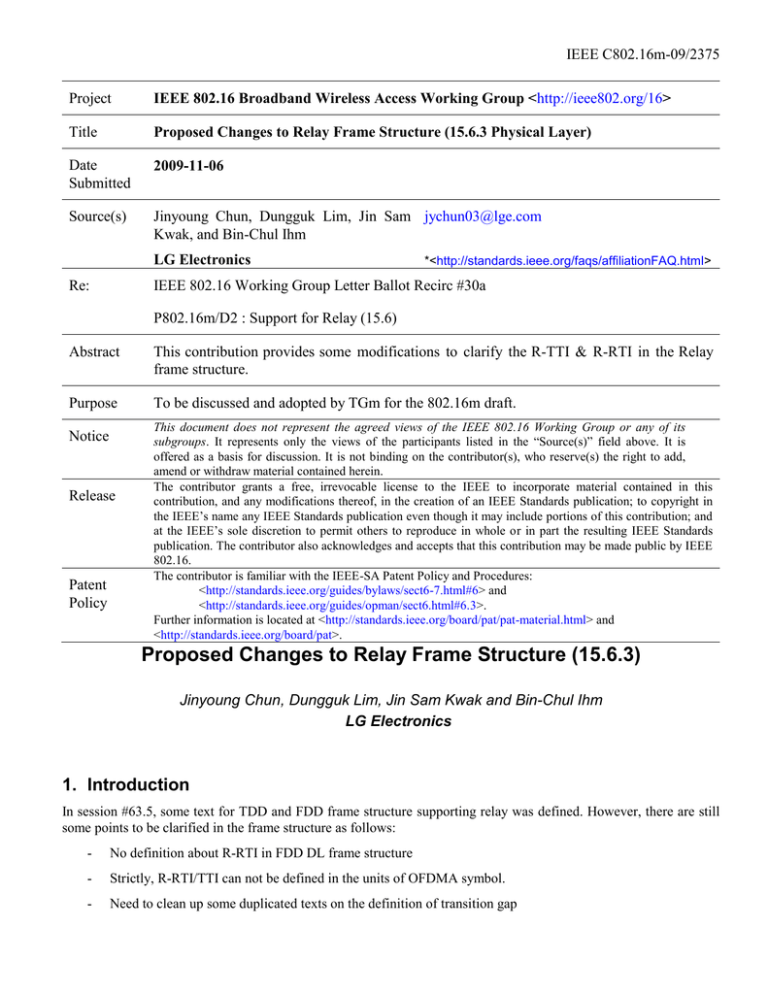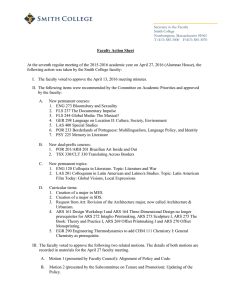IEEE C802.16m-09/2375 Project Title
advertisement

IEEE C802.16m-09/2375 Project IEEE 802.16 Broadband Wireless Access Working Group <http://ieee802.org/16> Title Proposed Changes to Relay Frame Structure (15.6.3 Physical Layer) Date Submitted 2009-11-06 Source(s) Jinyoung Chun, Dungguk Lim, Jin Sam jychun03@lge.com Kwak, and Bin-Chul Ihm LG Electronics Re: *<http://standards.ieee.org/faqs/affiliationFAQ.html> IEEE 802.16 Working Group Letter Ballot Recirc #30a P802.16m/D2 : Support for Relay (15.6) Abstract This contribution provides some modifications to clarify the R-TTI & R-RTI in the Relay frame structure. Purpose To be discussed and adopted by TGm for the 802.16m draft. Notice Release Patent Policy This document does not represent the agreed views of the IEEE 802.16 Working Group or any of its subgroups. It represents only the views of the participants listed in the “Source(s)” field above. It is offered as a basis for discussion. It is not binding on the contributor(s), who reserve(s) the right to add, amend or withdraw material contained herein. The contributor grants a free, irrevocable license to the IEEE to incorporate material contained in this contribution, and any modifications thereof, in the creation of an IEEE Standards publication; to copyright in the IEEE’s name any IEEE Standards publication even though it may include portions of this contribution; and at the IEEE’s sole discretion to permit others to reproduce in whole or in part the resulting IEEE Standards publication. The contributor also acknowledges and accepts that this contribution may be made public by IEEE 802.16. The contributor is familiar with the IEEE-SA Patent Policy and Procedures: <http://standards.ieee.org/guides/bylaws/sect6-7.html#6> and <http://standards.ieee.org/guides/opman/sect6.html#6.3>. Further information is located at <http://standards.ieee.org/board/pat/pat-material.html> and <http://standards.ieee.org/board/pat>. Proposed Changes to Relay Frame Structure (15.6.3) Jinyoung Chun, Dungguk Lim, Jin Sam Kwak and Bin-Chul Ihm LG Electronics 1. Introduction In session #63.5, some text for TDD and FDD frame structure supporting relay was defined. However, there are still some points to be clarified in the frame structure as follows: - No definition about R-RTI in FDD DL frame structure - Strictly, R-RTI/TTI can not be defined in the units of OFDMA symbol. - Need to clean up some duplicated texts on the definition of transition gap IEEE C802.16m-09/2375 - The definition of RTD should be clarified depending on the links between ABS and ARS or between ARS and AMS. - No description about the legacy support mode. 2. Text proposal in the 802.16m draft Proposed text has been underlined in blue and deleted text has been struck through in red. Existing draft text is shown in black. ---------------------------------------------------- Text Start --------------------------------------------------------------- [Modify the text in section 15.5.3 from line 55, page 571 in P802.16m_D2 as below:] 15.6.3 Physical Layer 15.6.3.1 Basic frame structure supporting ARS The advanced air interface supports two hop data transmission between ABS and AMS using an intermediate ARS. Figure 577 shows an example of the basic frame structure for system supporting ARSs. When an ARS is deployed it shall use the same OFDMA signal parameters (defined in Table 762) as its serving ABS. The ABS and ARS superframes shall be time aligned and shall consist of the same number of frames and subframes. Every ARS superframe shall contain a superframe header (SFH). The SFH transmitted by ARS shall have the same location and format as the SFH transmitted by ABS. The ARS preambles (SA-Preamble and PA-Preamble) shall be transmitted synchronously with superordinate ABS preambles. When ARSs are supported the ABS frame is divided on 16m Access zone and 16m Relay zone. The 16m Access zone position precedes the 16m Relay zone position inside the frame. The duration of the 16m Access zone and 16m Relay zone may be different in DL and UL directions. The zone configuration of 16m Access zone and 16m Relay zone is informed to the ARS by the ABS. The ABS frame 16m Access zone shall consist of 16m DL Access zone and 16m UL Access zone, and 16m Relay zone shall consist of 16m DL Relay zone and 16m UL Relay zone. The ABS 16m Access zone shall be used for communication with AMSs only. The ABS 16m Relay zone shall be used for communication with ARSs and may be used for communication with AMSs. In the 16m DL Relay zone the ABS shall transmit to its subordinate ARS and in the 16m UL Relay zone the ABS shall receive transmissions from its subordinate ARS. The ARS frame 16m Access zone shall consist of 16m DL Access zone and 16m UL Access zone and 16m Relay zone shall consist of 16m DL Relay zone and 16m UL Relay zone. The ARS 16m Access Zone shall be used for communication with AMSs only. In the 16m DL Relay zone the ARS shall receive transmissions from its superordinate ABS and in the 16m UL Relay zone the ARS shall transmit to its superordinate ABS. The position of 16m DL/UL relay zone is indicated for AMS using ABI. In each ARS frame, the relay transmit to receive transition interval (R-TTI) may be inserted in the last symbol of the 16m DL access zone of ARS in order to make allowances for ARSTTG and RTD between the IEEE C802.16m-09/2375 ARS and its superordinate station. If the R-TTI is present, the ARS DL subframe with the R-TTI is formed by type-3 or type-1 subframe when the ABS DL subframe is type-1 or type-2 subframe, respectively. If there is no R-TTI, the subframes in the DL Access zone at ARS are the same with those at ABS. In each ARS frame, the relay receive to transmit transition interval (R-RTI) may be inserted in the first symbol of the 16m UL Relay zone in order to make allowances for ARSRTG and RTD between the ARS and its superordinate station. If the R-RTI is present, the ARS UL subframe with the R-RTI is formed by skipping transmission of the first symbol of ABS UL subframe. The duration of R-TTI and R-RTI is defined in FDD (15.5.4.2.1) and TDD (15.5.4.2.1) respectively. The each R-TTI and R-RTI shall be equal or less than one OFDMA symbol. [Note: This text is in TDD and FDD section, separately. Here, it is not necessary.] ABS Transmission Superframe 20 ms SU0 SU1 SU2 SU3 Frame 5 ms F0 F1 F2 F3 Subframe SF0 SF1 SF2 SF3 SF4 SF5 SF6 SF7 SF0 SF1 SF2 SF3 SF4 SF5 SF6 SF7 ARS Transmission Frame 5 ms F0 SU0 F1 SU1 Superframe header SA-Preamble PA-Preamble F2 F3 SU2 SU3 Superframe 20 ms Figure xxx – Super-frame structure for system with ARS support When ARS is supported the long TTI allocations shall span the entire 16m Access zone or 16m Relay zone in any of DL or UL directions depending on where data transmission is allocated. 15.6.3.2 Frame structure 15.6.3.2.1 FDD frame structure The FDD frame shall be constructed on the basis of the basic frame structure defined in section 15.3.3. IEEE C802.16m-09/2375 An ARS supporting FDD mode shall communicate with the ABS using full duplex FDD mode and it shall be able to simultaneously support half duplex and full duplex AMSs operating on the same RF carrier. An ARS in FDD systems shall use DL carrier frequency (FDL) for receiving from the ABS in the 16m DL Receive zone and shall use UL carrier frequency (FUL) for transmission to the ABS in the 16m UL Transmit zone. The ARS radio frame in FDD system may have the relay transmit to receive transition interval (R-TTI) and the relay receive to transmit transition interval (R-RTI) in each DL frame and UL frame between 16m Access and 16m Relay zones. When an ARS switches the R-TTI in DL frame is necessary for an ARS to switch transceiver states from transmit to receive in DL frame, the last symbol of the 16m DL access zone of ARS may be used for the RTTI is the number of symbols between the last symbol that may be transmitted by the ARS and the first symbol to be received by the ARS in order to make allowances for RSTTG and RTD between the ARS and its superordinate station, where symbol times are referenced at the ABS. The R-TTI shall be calculated by following equation: 0 if RTD / 2 RSTTG R TTI 0 if RTD / 2 RSTTG 1 if RTD / 2 RSTTG R TTI Ts if RTD / 2 RSTTG (297) When an ARS switches transceiver states from receive to transmit in DL frame, the last symbol of the 16m DL relay zone of ARS and Idle time may be used to the R-RTI, which shall be calculated by following equation: IdleTime if IdleTime ( RSTTG RTD / 2) R RTI Ts IdleTime if IdleTime ( RSTTG RTD / 2) Where the RTD is the round trip delay between the ARS and its superordinate station and Ts is defined in Table 762. When an ARS switches transceiver states from receive to transmit or from transmit to receive in UL frame, the first symbol of UL relay zone and Idle time defined in Table 762 may be used for the R-RTI and the RTTI the R-RTI and R-TTI are provided by using an idle symbol located at the first symbol of UL Relay zone and Idle time defined in Table 647 as the following equation: 0 if RSTTG RSRTG Idle time R TTI R RTI (Ts Idle time) / 2 if RSTTG RSRTG Idle time (298) Figure 578 illustrates an example frame structure with ARS support for FDD mode, which is applicable to the nominal channel bandwidth of 5, 10, 20 MHz with G = 1/8. IEEE C802.16m-09/2375 Superframe: 20ms (4 frames, 32 AAI subframes) DL PHY Frame 5ms (AAI subframe + idle time) F0 F1 F2 F3 A-Preamble ABS DL/UL SF0(6) DL/UL SF1(6) DL/UL SF2(6) DL/UL SF3(6) DL/UL SF4(6) DL/UL SF5(6) DL/UL SF6(6) DL/UL SF7(6) ARS DL DL SF0(6) DL SF1(6) DL SF2(6) DL SF3(5) DL SF4(6) DL SF5(6) DL SF6(6) DL SF7(6) Idle time R-TTI DL Access Zone ARS UL UL SF0(6) UL SF1(6) UL SF2(6) R-RTI DL Relay Zone UL SF3(6) UL SF4(5) UL SF5(6) UL SF6(6) UL SF7(6) R-RTI UL Access Zone R-TTI UL Relay Zone Figure 578 - Example of ARS FDD frame structure with G=1/8 in 5/10/20MHz 15.6.3.2.2 TDD frame structure The TDD frame shall be constructed on the basis of the basic frame structure defined in Sections 15.3.3. An ARS radio frame in TDD system may have an R-TTI in DL and an R-RTI in UL between 16m Access and 16m Relay zones. When an ARS switches transceiver states from transmit to receive, the last symbol of the 16m DL access zone of ARS may be used for the R-TTI is the number of symbols between the last symbol that may be transmitted by the ARS and the first symbol to be received by the ARS in order to make allowances for RSTTG and RTD between the ARS and its superordinate station, where symbol times are referenced at the ABS. The R-TTI shall be calculated by following equation: 0 if RTD / 2 RSTTG R TTI 0 if RTD / 2 RSTTG 1 if RTD / 2 RSTTG R TTI Ts if RTD / 2 RSTTG (299) where the RTD is the round trip delay between the ARS and its superordinate station and Ts is defined in Table 762. When an ARS switches transceiver states from receive to transmit, the first symbol of the 16m UL relay zone of ARS may be used for the R-RTI is the number of symbols between the last symbol that may be transmitted to the ARS and the first symbol to be transmitted by the ARS in order to make allowances for RSRTG and RTD between the ARS and its superordinate station, where symbol times are referenced at the ABS. The RRTI shall be calculated by following equation: IEEE C802.16m-09/2375 0 if TTG R _ IdleTime RTD RSRTG R RTI ( RSRTG R _ IdleTime RTD TTG ) / Ts if TTG R _ IdleTime RTD RSRTG 0 if TTG R _ IdleTime RTD RSRTG R RTI ( RSRTG R _ IdleTime R _ RTD TTG ) / Ts Ts if TTG R _ IdleTime RTD RSRTG (300)where the RTD is the round trip delay between the ARS and its superordinate station and R_IdleTime, which is the time interval between 16m DL Relay zone and 16m UL access zone, is equal to or larger than M_RTD/2, where M_RTD is the round trip delay between the AMS and its superordinate station. When R_IdleTime is the same with TTG, the R-RTI is one OFDMA symbol. Figure 579 illustrates an example frame structure with ARS support for TDD mode D:U = 5:3, which is applicable to the nominal channel bandwidth of 5, 10, 20 MHz with G = 1/8. The number of subframes allocated to the Relay zone in DL direction is two and in UL direction is one. The R-TTI and R-RTI duration is equal to the duration of one OFDMA symbol. Superframe: 20ms (4 frames, 32 subframes) UL/DL PHY Frame 5ms (8 subframes) F0 F0 F0 A-Preamble F0 TTG RTG ABS DL SF0(6) DL SF1(6) DL SF2(6) DL SF3(6) DL SF4(5) UL SF5(6) UL SF6(6) UL SF7(6) ARS DL SF0(6) DL SF1(6) DL SF2(5) DL SF3(6) DL SF4(5) UL SF5(6) UL SF6(6) UL SF7(5) R-TTI DL Access Zone R_IdleTime DL Relay Zone RTG R-RTI UL Access Zone UL Relay Zone Figure 579 - Example of ARS TDD frame structure with G=1/8 in 5/10/20MHz 15.6.3.2.3 Relay frame structure supporting the WirelessMAN-OFDMA frames If ABS supports WirelessMAN-OFDMA frame, ARS frames follow the Advanced Air Interface frames in 15.3.3.5. 15.5.3.3 Relay Downlink PHY Structure 15.5.3.4 Downlink Control Structure In the 16m DL Access zone of the ABS frame and ARS frame, all the DL control channels described in section 15.3.6 are reused. IEEE C802.16m-09/2375 In the 16m DL Relay zone, only the A-MAP control channel described in Section 15.3.6 is reused for communication between the ABS and the ARS. 15.5.3.4.1 Advanced preamble for relay ARS reuses PA-preamble and SA-preamble in section 15.3.6.1. 15.5.3.4.2 MIMO Midamble and Relay amble The ABS transmits MIMO midamble for ARS. The ARS transmits MIMO midamble for AMS served by ARS. 15.5.3.5 Relay Uplink physical structure 15.5.3.5.1 Uplink data subcarrier mapping The data subcarrier mapping rule in UL Relay zone corresponds to the rule described in 15.3.10.2.3. To support R-RTI insertion the ARS in the first UL subframe of the 16m UL Relay zone shall perform data resource mapping starting from the second symbol of the subframe skipping the symbol where R-RTI is placed. Pilots shall not be transmitted on the subcarriers that belong to the first OFDMA symbol of the subframe where R-RTI is placed. 15.5.3.6 Uplink Control Structure In both 16m UL Access zones of ABS/ARS frames, all UL control channels described in section 15.3.9 are reused. To support R-RTI insertion the ARS in the first subframe of the 16m UL Relay zone shall perform resource mapping of fast feedback control channels described in Section 15.3.9 but shall not transmit them on subcarriers that belong to the first OFDMA symbol of the subframe where R-RTI is placed. The ABS shall process the ARS UL control signals, assuming that ARS has punctured the subcarriers and pilots that belong to the first OFDMA symbol where R-RTI is placed. The UL BR channel for ARS is transmitted separately with the UL BR channel for AMS connected to ABS, and the UL HARQ and fast feedback channels transmitted by ARS to ABS are transmitted in the same region with those for AMS connected to ABS. In this case, the UL HARQ feedback channel for ARS is transmitted by puncturing one HARQ HMT in the first and second symbols described in section 15.3.9.2.2. ---------------------------------------------------- Text End ---------------------------------------------------------------


